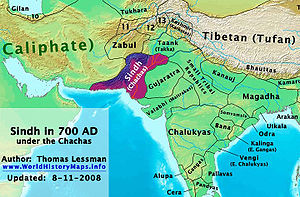- Chach of Alor
-
Chach (610-682)[1] is the name of the Brahmin Chamberlain and Secretary to Rai Sahasi the Second, of the Rai Dynasty who succeeded him to the throne of Sindh.[1] The history of Chach is related in the Chach Nama as part of the history of Sind. Several places along the Sindhu river are named after the adored king. For example, there are Chachpur, Chachar, Chachro, Chachgaon, Chachi.[2]
Contents
Rise to Power
Chach was a Brahmin who rose to a position of influence under the Rai Sahasi of the Rai Dynasty of Sindh as both Chamberlain and Secretary.[3] Incensced, the Rana Maharath, the King of Chittor, who was the brother Rai Sahasi then claimed the throne and attacked Chach but the Rana was killed by strategem, in the war in 640.[1][4]
Chach then enlisted his brother Chandra to help him administer the realm and set off with an army to bring the rest of the realm under his control. He is reported to have fought battles at Babiah on the south bank of the River Beas, at Iskandah and at Sikkah where "Chach Rai took possession of the fort (of Sikkah), and killed 5,000 warlike men who were in it, and made the other residents of the town prisoners, and secured a large booty and a great number of slaves."[5] After which he appointed a Thakur at Multan and rode unopposed to settle his boundary with Kashmir. During his campaigns, Chach defeated and subjugated the Siwistani chief Matta.
Later he expanded his rule subduing neighbouring Buddhist regions across the Indus River culminating in a battle at Brahmanabad, killing Buddhist Governor of Brahmanabad, Agham Lohana. He stayed there for a year cementing his control by various means such as:
- Marrying the widow of the king Agham
- Marrying his niece to Agham's son Sarhand
- Taking hostages
- Prohibiting the Jat and Lohana tribes from carrying weapons.
He further placed upon the Jat and Lohana restrictions such as:
- Forbidding them riding horses with saddles
- Forbidding them from wearing silk or velvet
- Forbidding them from wearing headgear or footwear
- Forcing them to wear black or red scarves
From there he then marched into Sassanid territory the town of Armanbelah, and through Turan to Kandahar from where he exacted tribute before returning.
In the 35th year of the reign of the Raja Sahasi Rai II, 636, the Chach Nama reports the repulsion of an Arab raid on Debal and Thana. The raid was meant for the purpose of looting the coastal cities and were not actually permitted by the Caliph Umar, who later dismissed the governor of Bahrain due to his independent act of raiding with out permission from caliphate. It was under Mughaira bin A's, who died in this battle at Debal. In 644, after Conquering Persian Empire, Rashidun army entered makran and defeated the army of Raja Sahasi Rai II in a decisive Battle of Rasil, and annexed Makran and eastern Balochistan. Caliph Umar (634-644) however for the time being, disapproved of any incursion beyond the Indus river and ordered his commander to consolidate their position west of indus.[6] During the reign of Caliph Uthman ibn Affan (644-656) Muslims captured Qanzabil, a main military garrison of Rai dynasty in northern Sindh and until 662, when during Ummayad Caliphate it was retaken by Rai kingdom, it served as eastern most garrison town of Rashidun army.
Succession
Chandar
Chandra (671-679)[7] succeeded by his brother. Chandar, the Buddhist[8] ascetic had to also defend his realm from the King Siharas of Kannauj and after a protracted siege of the capital Aror, the Siharas was captured during a conflict at a parley and peace concluded by means of hostages[citation needed]. Chandra was reputed to have ruled for 8 years.
Dahir
Main article: Raja DahirChach's eldest son Dahir then succeeded his uncle Chandar.
Footnotes
- ^ a b c Wink pg. 153
- ^ P. 653 The cyclopædia of India and of Eastern and Southern Asia By Edward Balfour
- ^ Chach-nama
- ^ The Chach Nama recounts the Ranas death as one in a single combat duel with Chach wherein Chach cheated and mounted to win.
- ^ The Chachnamah, An Ancient History of Sind, Giving the Hindu period down to the Arab Conquest. Translated by from the Persian by MIRZA KALICHBEG FREDUNBEG,Commissioners Press 1900. Section 10
- ^ http://dsal.uchicago.edu/reference/gazetteer/pager.html?objectid=DS405.1.I34_V06_281.gif
- ^ Wink, pg. 153
- ^ P. 151 Al-Hind, the Making of the Indo-Islamic World By André Wink
References
- Mirza Kalichbeg Fredunbeg: The Chachnamah, An Ancient History of Sind, Giving the Hindu period down to the Arab Conquest. Translated by from the Persian by, Commissioners Press 1900 [1]
- Thakur Deshraj: Jat Itihas, Delhi, 1934
- Wink, Andre, Al Hind the Making of the Indo Islamic World, Brill Academic Publishers, Jan 1, 1996, ISBN 90-04-09249-8
Categories:- History of Sindh
- People in the history of Pakistan
- Hindu monarchs
- History of Rajasthan
- 7th-century monarchs in Asia
- Chach nama
Wikimedia Foundation. 2010.

